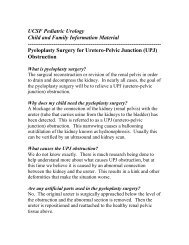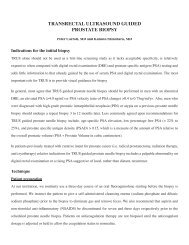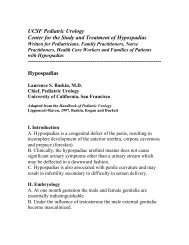Hydronephrosis: Prenatal Diagnosis - UCSF Department of Urology
Hydronephrosis: Prenatal Diagnosis - UCSF Department of Urology
Hydronephrosis: Prenatal Diagnosis - UCSF Department of Urology
- No tags were found...
Create successful ePaper yourself
Turn your PDF publications into a flip-book with our unique Google optimized e-Paper software.
2) An ultrasound done as a routine evaluation for another<br />
medical problem, such as a urinary tract infection or incontinence,<br />
may also reveal hydronephrosis.<br />
Once hydronephrosis is noted, whether is it during pregnancy or<br />
later, additional tests are <strong>of</strong>ten required in order to find out the<br />
significance <strong>of</strong> the hydronephrosis. These tests are important<br />
because children with hydronephrosis may have an anatomic<br />
abnormality or urinary tract blockage. Early diagnosis and<br />
treatment <strong>of</strong> a potential urologic abnormality can prevent urinary<br />
tract infections and permanent kidney damage or scarring.<br />
What, if any, other test should be done?<br />
• VCUG (voiding cystourethrogram): This study gives us<br />
important information regarding the shape and size <strong>of</strong> the<br />
bladder, the bladder neck (or opening) and the tubes that drain<br />
the urine from the kidneys into the bladder, called ureters. It<br />
allows us to diagnose reflux (the abnormal back-flow <strong>of</strong> urine<br />
from the bladder into the ureter and up to the kidney). It also<br />
gives us additional anatomic information about the urethra<br />
(urine tube which takes urine from the bladdder outside the<br />
body) to make sure no blockage is present (posterior urethral<br />
valves).<br />
• Kidney (Renal) Scan: This test may be done depending on the<br />
history <strong>of</strong> urinary tract infection(s), result <strong>of</strong> VCUG, and/or the<br />
severity <strong>of</strong> the hydronephrosis. It is used to better demonstrate<br />
the actual function and/or drainage <strong>of</strong> the kidneys. A kidney<br />
scan can also show if there is kidney damage and/or scarring<br />
that may have resulted from a previous urinary tract infection or<br />
long-standing hydronephrosis. Two types <strong>of</strong> renal scans are<br />
typically performed depending on the diagnosis.










